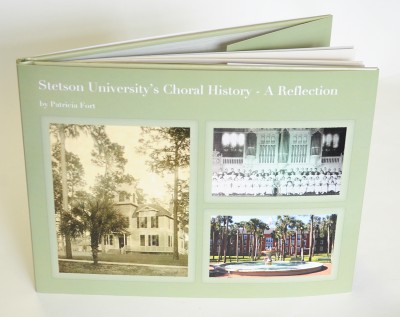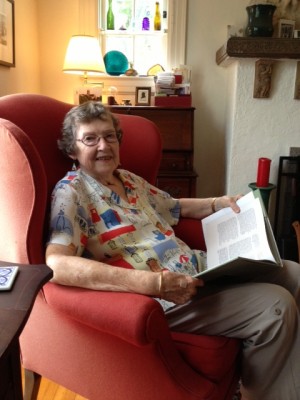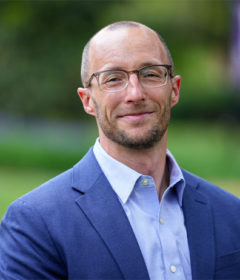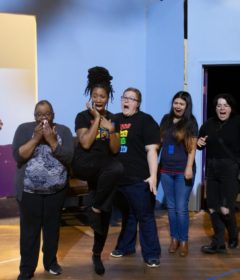Stetson’s Choral Tradition preserved in book
 When you first enter her home, it is very clear to see that Mrs. Patricia Fort has not only a welcoming presence but also has made her home a haven for students of her husband Dr. Robert Fort, Stetson’s choral director between 1965 and 1994. Mrs. Fort, pictured below in her home, fondly remembers hosting choir suppers during those years “just because we enjoyed the students.”
When you first enter her home, it is very clear to see that Mrs. Patricia Fort has not only a welcoming presence but also has made her home a haven for students of her husband Dr. Robert Fort, Stetson’s choral director between 1965 and 1994. Mrs. Fort, pictured below in her home, fondly remembers hosting choir suppers during those years “just because we enjoyed the students.”
As a young newlywed, Mrs. Fort was a schoolteacher in Teaneck, N.J., while her husband was attending Union Seminary in New York City, which offered the most prestigious program in his field.
In 1965, while serving as organist/choirmaster in a large church in Cleveland, Fort was recruited to Stetson to supervise the Church Music Degree program as well as serve as Director of the University Chorus. It was his respect for the work of nationally known University Organist Paul Jenkins, and Stetson’s then Dean of Music Paul Langston, who had also attended Union Seminary, as well as his desire to be closer to his mother, that led Fort and his wife to venture south.
 Both Dr. and Mrs. Fort loved liturgical music and served on national boards of the Presbyterian Church and planned conferences together. He was a church organist from the age of 16, and later served throughout his career as both organist and choir director.
Both Dr. and Mrs. Fort loved liturgical music and served on national boards of the Presbyterian Church and planned conferences together. He was a church organist from the age of 16, and later served throughout his career as both organist and choir director.
Fort’s love was to lead choirs. His great passion was to help students reach the height of their musical talents.
After Dr. Fort’s death, his widow was encouraged by Dr. Timothy Peter, professor of Music and director of Choral Activities, to preserve the history of Stetson’s great choral program by writing a book. They collaborated to develop Stetson University’s Choral History to help the current generation of students better understand the legacy of Stetson’s choral programs, but also as a keepsake for alumni who experienced singing in Stetson’s various choirs.
Peter, who joined Stetson in 2012 and has a deep respect for the history of the program, encouraged Mrs. Fort to illustrate the book with appropriate photographs, which came from Stetson University Archives, the Office of University Marketing, and various personal collections.
Since Stetson doesn’t have its own university press, it was Brian Rodriguez, currently a senior music and business major and member of the Concert Choir, who was approached with the task of graphically designing her book.
“Good things are messy,” Peter explained, “but Patty was quite faithful and wonderful in the editing process. She caught most of the needed changes.”
Rodriguez worked diligently until its completion and published it using a Mac on IBook. “Brian is a fine man – bright, talented and sincere,” said Peter. “We enjoyed working with him.”
The book takes us back to 1901 with the first mention of a Glee Club at Stetson and it was in 1904 that the probable first Florida performance of Handel’s Messiah was given by the then DeLand Choral Society under the direction of Stetson’s School of Music Director. The School also held music festivals that attracted talent from Chicago, Philadelphia and New York to sing the lead roles.
But it was in 1935 that Stetson’s “Prof” Harold M. Giffin arrived on campus as Choral Director, and after serving in World War II, returned to lead the department from 1946 through 1972. It was under “Prof’s” leadership that the choral program saw its primary growth with the development of the Glee Club, which included men’s and women’s choruses and small mixed ensembles. “The campus was pervaded by the sound of music,” Mrs. Fort writes in her book.
In 1960, Professor Paul Langston joined Stetson and led the Church Music program for majors. At that time, many Stetson students were Baptist and came to the university to become organists and choir directors in Baptist churches, making this major a critical source of Stetson’s income. Langston’s newly formed University Chorus performed at one of the two weekly chapel services on campus.
After becoming Dean in 1963, Langston was replaced by Fort, who was at the time still a doctoral candidate in Sacred Music at Union Seminary. Fort formed a small early music ensemble called “Collegium Musicum,” and when chapel attendance no longer was mandatory, he created a Chapel Choir, which sang weekly for chapel services. In an effort to help church music majors prepare for the demanding schedules for church musicians, Fort held 7 a.m. rehearsals.
While Dr. and Mrs. Fort enjoyed their long association with Stetson through the majority of their life, Dr. Fort passed on just months shy of their 50th wedding anniversary.
“An alum from Maine took a bus all the way to Florida; another alum arrived from Wisconsin; others came from New York City and Philadelphia, all making the journey to attend his memorial service in Lee Chapel,” said Mrs. Fort. These gestures meant the world to her.
With her fitting tribute to her husband and Stetson University’s esteemed School of Music that he so loved, as well as the work of the other choral conductors during the 40 years between Giffin and Peter, who shaped what it has become today, Mrs. Fort’s book truly captures its rich history and legacy.
Stetson University’s Choral History is available for sale in the Presser Hall Music office for $20. Please call 386-822-8950.
By Mary M. McCambridge



